Local Area Labour Markets in Scotland - Statistics from the Annual Population Survey 2011
Summary publication of results from the Annual Population Survey 2011, presenting analysis on the labour market, education and training. Results are provided for Scotland and local authority areas in Scotland.
Section 1: People in Work
Country level analysis
Improving participation in Scotland's labour market is a key driver in meeting the Scottish Government's overarching Purpose of increasing sustainable economic growth.
The latest trends in Scotland's labour market are monitored monthly using the rolling quarterly Labour Force Survey (LFS) and data can be accessed on the Office for National Statistics (ONS) website[1].
Scotland entered recession in Quarter 3 of 2008, two quarters later than the UK economy. Scotland subsequently returned to growth in Quarter 4 of 2009, one quarter later than the UK. However, growth through 2010 and 2011 was slow, with the employment rate continuing to deteriorate through Q1 of 2010, before making a gradual recovery through to the second quarter of 2011, although this has weakened over the past few quarters.
More detailed analysis of the latest headline trends, updated monthly, is available from:
http://www.scotland.gov.uk/Topics/Statistics/Browse/Labour-Market/AnalyticalPapers
The APS remains the best source for local area labour market trends, as the sample size on quarterly LFS is too small to be used to monitor trends below Scotland-level.
Participation
The APS is used to measure progress for the second part of the Government's Participation target, which aims to close the gap with the top five OECD economies. Further information on this and other purpose targets and indicators that use the APS to track their progress is available in Annex B and also from the Scotland Performs website at:
http://www.scotland.gov.uk/About/scotPerforms
The employment rate in Scotland, using the European age definition (15-64), in 2011 was 69.5% which is 0.3 percentage points lower than the previous year. Scotland has the 13th highest employment rate of the OECD countries. Between 2010 and 2011 the gap in employment rates between Scotland and the country with the 5th highest rate (Denmark in 2010 and now Sweden in 2011) increased from 3.7 percentage points in 2010 to 4.6 percentage points in 2011.
Local area and sub-group analysis
Table 1 in Annex A gives the employment rate for the population aged 16 to 64 in Scotland's local authorities for 2008, 2010 and 2011. A time-series back to 2004 can be downloaded from the web-tables at:
http://www.scotland.gov.uk/Topics/Statistics/Browse/Labour-Market/Local-Authority-Tables
or from Scottish Neighbourhood Statistics at:
http://www.sns.gov.uk/
The local authorities with the highest employment rates in Scotland during 2011 were: Shetland Islands, Aberdeenshire and Orkney Islands, at (81.3%, 79.6% and 79.3% respectively) while the those with the lowest employment rates were North Ayrshire, Eilean Siar and Glasgow City with 61.0%, 63.6% and 63.8% respectively. Map 1 shows how employment rates vary across Scotland. There are some signs of a geographic trend, with local authority areas in the north generally fairing best, and those in western central belt and south west of Scotland fairing worst.
Based on the APS, between 2010 and 2011, the employment rate across Scotland decreased from 71.0% to 70.7%, a decrease of 0.3 percentage points. During the same time period, the employment rate for the UK as a whole decreased marginally from 70.2% to 70.0%. Over the year, the employment rate increased in 11 local authorities and decreased in 21 local authorities. Of the 11 local authorities which saw an increase in their employment rate over the year, Scottish Borders saw the largest increase, up 2.4 percentage points followed by Glasgow City and West Dunbartonshire, both up by 1.7 percentage points.
Over the year the largest decreases in employment rate were seen in Clackmannanshire, where there was a decrease of 10.5 percentage points, and in Eilean Siar and Shetland Islands which saw decreases of 5.1 and 4.3 percentage points respectively.
Between 2008 and 2011 the employment rate across Scotland decreased from 73.5% to 70.7%, a decrease of 2.8 percentage points. The employment rate in 2011 was lower than the employment rate in 2008 in all 32 local authorities, as shown in Chart 1. However, the employment rate in 2011 is within 1 percentage point of the 2008 employment rate in three local authorities: Highland; Aberdeenshire; and North Lanarkshire. Between 2008 and 2011 the largest decreases in employment rate were seen in Eilean Siar (a decrease of 13.8 percentage points from 77.4% to 63.6%), North Ayrshire (a decrease of 7.9 percentage points from 68.9% to 61.0%) and South Ayrshire (a decrease of 6.5 percentage points from 72.4% to 65.9%).
Map 1 - Employment rate for population aged 16-64, by local authority, Scotland, 2011
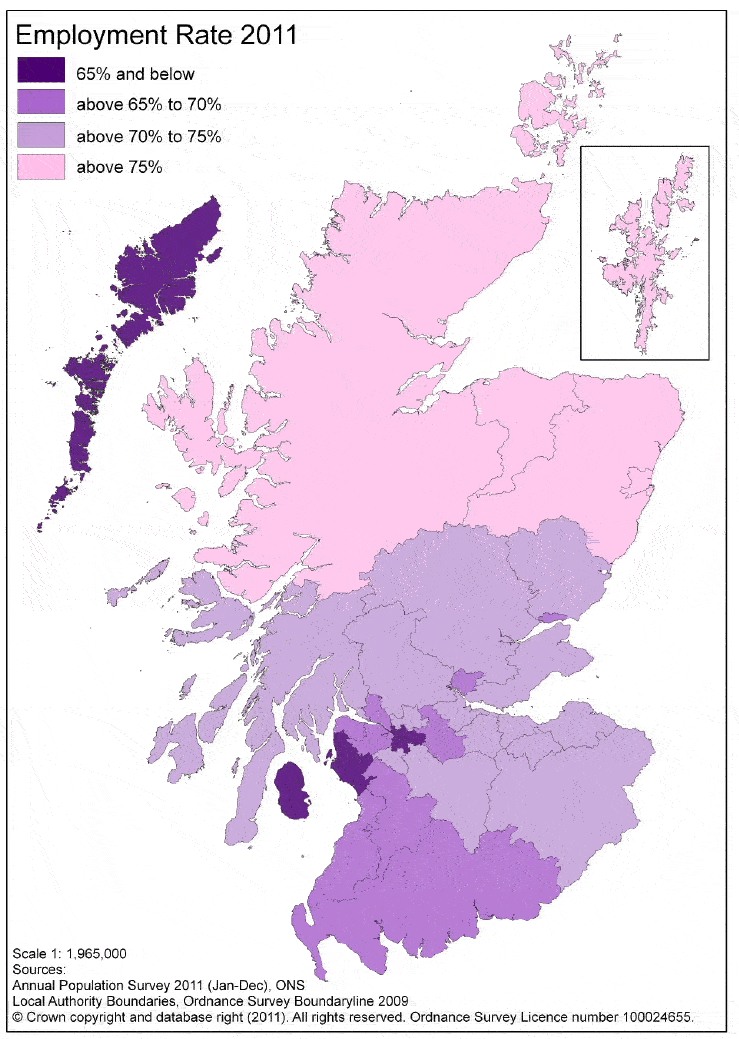
Chart 1- Employment rates (16-64) by local authority, Scotland, change over three years (2008-2011)
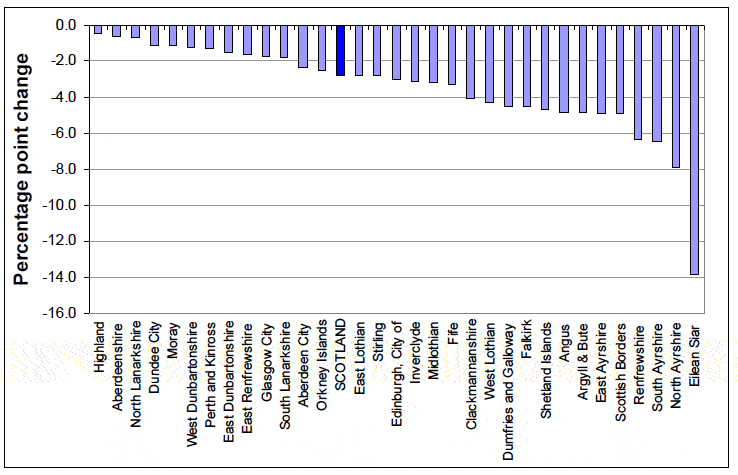
Source: Annual Population Survey, Jan-Dec, ONS
Cohesion
The APS is used to measure progress against the Government's Cohesion target, which aims to narrow the gap in participation between Scotland's best and worst performing regions by 2017. Further information on this and other purpose targets and indicators that use the APS to track their progress is available in Annex B and also from the Scotland Performs website at:
http://www.scotland.gov.uk/About/scotPerforms
The employment rate in Scotland varies considerably between local authority areas. The difference between the 3 best areas and the 3 worst performing local authority areas was on a downward trend between 2004 and 2008. Between 2008 and 2009 the gap increased. Since 2009 the gap has been reducing slowly but has not returned to the level seen in 2008. The most recent data shows that the employment rates are more stable and the gap between the top three and bottom three performing local authorities has reduced by 2.4 percentage points to 16.3 percentage points. However, this is generally due to deterioration in the position of the best performing areas, rather than an improvement in the worst performing areas.
Analysis by gender
Males
Between 2010 and 2011 the male employment rate in Scotland increased slightly from 74.8% to 75.1%. In 2011 Aberdeenshire, Shetland Islands and Moray were the local authorities with the highest male employment rates (at 86.9%, 85.4% and 84.1% respectively) while those with the lowest male employment rates were Eilean Siar, North Ayrshire and Inverclyde (at 60.3%, 65.3% and 67.6% respectively).
The male employment rate increased in 15 local authorities and decreased in 17 local authorities over the year. Eilean Siar, Clackmannanshire and Inverclyde saw the largest decreases in their male employment rates whilst Glasgow City, West Dunbartonshire and Stirling saw the largest increases.
Between 2008 and 2011 the male employment rate across Scotland decreased from 78.8% to 75.1%, a decrease of 3.7 percentage points. The male employment rate in 2011 was higher than the employment rate in 2008 in 5 local authority areas: Aberdeenshire, Dundee City, Glasgow City, East Dunbartonshire and Perth and Kinross. Between 2008 and 2011 the largest decreases in male employment rate were seen in Eilean Siar (down 20.1 percentage points from 80.4% to 60.3%), North Ayrshire (down 11.3 percentage points from 76.6% to 65.3%) and South Ayrshire (down 9.9 percentage points from 78.5% to 68.6%).
Females
Between 2010 and 2011 the female employment rate in Scotland decreased slightly from 67.4% to 66.5%. In 2011 Orkney Islands, Shetland Islands and Highland had the highest female employment rates (at 77.2%, 77.0% and 73.6% respectively) while those with the lowest female employment rates were North Ayrshire Glasgow City and Clackmannanshire (at 57.1%, 57.2% and 58.7% respectively).
The female employment rate increased in 10 local authorities and decreased in 20 local authorities over the year. Clackmannanshire, Dumfries and Galloway and Shetland Islands saw the largest decreases in their female employment rate whilst Eilean Siar, Orkney Islands and Scottish Borders saw the largest increases.
Between 2008 and 2011 the female employment rate across Scotland decreased from 68.4% to 66.5%, a decrease of 1.9 percentage points. The female employment rate in 2011 was higher than the employment rate in 2008 in 5 local authority areas: Highland, Midlothian, North Lanarkshire, Orkney Islands and South Lanarkshire. Between 2008 and 2011 the largest decreases in female employment rate were seen in Clackmannanshire (down 7.1 percentage points from 65.8% to 58.7%), Eilean Siar (down 7.1 percentage points from 74.2% to 67.1%), and in Renfrewshire (down 6.6 percentage points from 67.3% to 60.7%).
Employment levels and rates by gender for 2004 to 2011 are provided in the web tables and via Scottish Neighbourhood Statistics.
Analysis by age
Chart 2 shows how the employment rate for different age groups has changed since 2004 in Scotland.
Chart 2 - Employment rate by age group, Scotland, 2004-2011
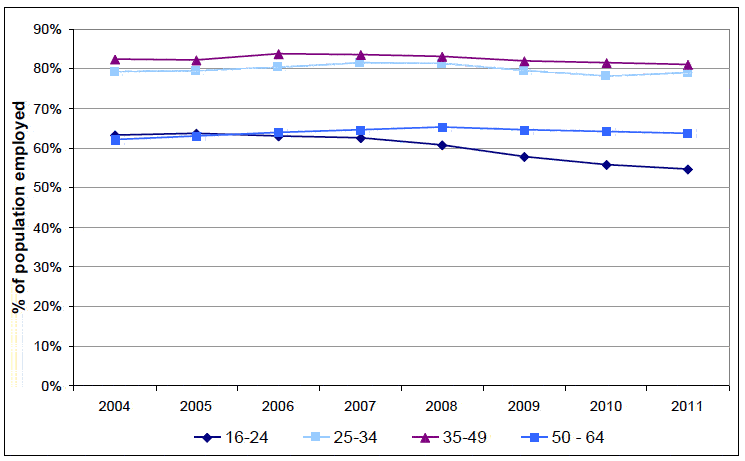
Source: Annual Population Survey, Jan-Dec, ONS
16-24 years
In Scotland, the proportion of this age group in employment decreased between 2008 and 2011, from 60.8% in 2008, to 55.6% in 2010 and 54.6% in 2011.
Analysis by local authority is provided in the Youth Employment section.
25-34 years
For Scotland, the percentage in employment in this age group had decreased from 81.2% in 2008 to 77.9% in 2010. However, over the last year it increased by 1.1 percentage point to 79.0% in 2011.
Across local authorities in 2011, the highest employment rates for this age group were in Moray (86.6%), Perth and Kinross (86.5%), East Dunbartonshire (84.6%) and Highland (84.6%) while the lowest were in East Ayrshire (67.7%), Stirling (71.1%) and North Ayrshire (71.8%).
Over the year the largest decreases were in Stirling (down 11.9 percentage points) and East Ayrshire (down 10.4 percentage points. The largest increases were in Midlothian (up 9.0 percentage points) and East Lothian (up 8.5 percentage points).
35-49 years
For Scotland, between 2008 and 2011, the percentage in employment in this age group has decreased from 83.1% in 2008 to 81.5% in 2010, and to 81.1% in 2011.
Across local authorities, in 2011, the highest employment rates for this age group were in Shetland Islands (97%), Aberdeenshire (89.2%), Highland (88.4%) and the lowest were in North Ayrshire (71.3%), Glasgow City (72.3%) and Renfrewshire (74.5%).
Over the year the largest decreases were in Clackmannanshire (down 14 percentage points), Dumfries and Galloway (down 5.5 percentage points), Inverclyde (down 4.4 percentage points). The largest increase was in North Lanarkshire (3.3 percentage points), Scottish borders (3.2 percentage points) and Falkirk (2.4 percentage points).
50-64 years
For Scotland, between 2008 and 2011, the percentage in employment in this age group decreased from 65.2% in 2008 to 64.1% in 2010, and to 63.7% in 2011.
Across local authorities, in 2011, the highest employment rates for this age group were in Shetland Islands (79.2%) and Highland (72.5%) and the lowest were in Glasgow (53.3%), and North Ayrshire (55%).
Over the year largest decreases were in Aberdeen City (down 5.1 percentage points), Inverclyde (down 3.9 percentage points) and Clackmannanshire (down 3.8 percentage points). The largest increases were in Edinburgh (4.0 percentage points) East Lothian (2.3 percentage points) and South Lanarkshire (1.5 percentage points).
Employment levels and rates by age for 2011 are provided in Table 3 in Annex A, with full time series data from 2004 to 2011 available in the web tables and via Scottish Neighbourhood Statistics.
Youth Employment (16-24 year olds)
Estimates of youth employment, unemployment and activity in Scotland are released on a monthly basis by the ONS. Secondary analysis from the Scottish Government and a link to the primary ONS regional analysis can be found on the Statistical Briefing section of the Labour Market Statistics section of the Scottish Government website:
http://www.scotland.gov.uk/Topics/Statistics/Browse/Labour-
Market/AnalyticalPapers#Youth%20Unemployment%20Publications%20and%20Briefing
These estimates are based on rolling quarterly LFS data. Due to relatively small sample sizes the LFS estimates cannot be broken down to give reliable youth employment estimates by local authority, occupation or industry. However, it is possible to produce this analysis using data from the APS.
Youth Employment in Local Authorities
The local authorities with the highest youth employment rates in Scotland in 2011 were: Moray, Aberdeenshire and Orkney Islands (72.8%, 71.5% and 66.1% respectively). The local authorities with the lowest youth employment rates were North Ayrshire, Renfrewshire and Angus (42.4%, 46.0% and 46.5% respectively).
Note that in some local authorities there is a large student population which may be expected to lead to higher inactivity among 16-24 year olds and hence lower employment (and unemployment). However, it is important to note that 36.0% of full-time students in Scotland were also in employment in 2011. This is higher than the percentage in the UK as a whole, where 26.9% of full-time students were also in employment. Due to sample size limitations it is not possible to look at local authority employment rates by enrolment in full-time education.
The youth employment rate in Scotland decreased by 1.0 percentage point over the year, from 55.6% in 2010, to 54.6% in 2011. A total of 15 local authorities saw a decrease in their youth employment rate over the same period whilst 15 saw an increase in their employment rate (including Edinburgh and Glasgow). The 2011 estimates for Clackmannanshire and Eilean Siar have been suppressed as they are unreliable due to small sample sizes.
Over the year the largest decrease in youth employment rate was seen in the Shetland Islands, where there was a decrease of 12.5 percentage points. However, it should be noted that, despite this decrease, the Shetland Islands had the sixth highest youth employment rate in Scotland in 2011. We saw a similar scenario in Aberdeen City which saw the second largest decrease over the year (a decrease of 6.9 percentage points) but had the fourth highest youth employment rate in Scotland in 2011.
Between 2008 (when the economy went into recession) and 2011, the youth employment rate in Scotland decreased by 6.2 percentage points. A total of 26 local authorities saw a decrease in their youth employment rate over the same period whilst only 4 saw an increase in their employment rate (Moray, Aberdeen City, East Dunbartonshire and Fife).
Between 2008 and 2011 the largest decreases in youth employment rate were seen in Angus (a decrease of 22.9 percentage points from 69.4% to 46.5%), East Lothian (a decrease of 18.7 percentage points from 69.4% to 50.7%) and Renfrewshire (a decrease of 18.2 percentage points from 64.2% to 46.0%).
Work Patterns
In 2011 73.6% of people in employment were working full time[2], compared to 73.8% in 2010 and 76.2% in 2008. Note that as full-time and part-time working is self-classified, it is possible that some of those working full-time may not be working over 30 hours per week. The percentage of people in full-time work has decreased in 16 local authority areas over the year and has decreased in 27 local authorities since 2008. Only four local authority areas have been on an upward trend both over the year and since 2008, these are Clackmannanshire; Eilean Siar; Aberdeen City; and South Lanarkshire.
Levels and percentages for full-time/part-time employment, self-employment and workers with second jobs at Local Authority level are available in the web tables and via Scottish Neighbourhood Statistics.
As well as examining the overall employment rate and people's working patterns, it is useful to look at those who are underemployed: that is, those who are already in employment, but who would prefer to work more hours than they actually do (see Box 1 for full definition). Underemployment can provide an indication of underutilisation of labour.
| Box 1 - Definition of underemployment |
|---|
Underemployment includes all employed persons aged 16 and over who during the reference week were willing to work additional hours, meaning that they:
|
In 2011 there were 204,200 workers who were underemployed (looking for extra hours in their current job), 8.3% of all employed people over 16. Of these, 117,100 were part-time workers (17.4% of all part-time workers over 16), while 87,100 were full-time workers (4.9% of all full-time workers over 16). Chart 3 below shows how the number of people who were underemployed has changed since 2004 for males and females in full-time and part-time work. This illustrates that although underemployment is more prevalent within those who are in part-time jobs, it is by no means restricted to this group. Underemployment levels for both male and female part-time workers have been increasing steadily since 2008.
Underemployment levels are highest amongst part-time female and full-time male workers.
- Underemployment levels for males working part-time has increased from 21,400 in 2008 to 35,700 in 2011, an increase of 67%, while for males working full-time, the level rose from 49,400 in 2004 to 61,500 in 2011 - a 25% increase.
- Underemployment levels for females in part-time employment increased from 56,800 in 2008 to 81,400 in 2011, an increase of 43%, while for females working full-time, the level rose from 23,000 in 2004 to 25,600 in 2011 - a 12% increase.
Chart 3 - Underemployment level for full-time and part-time workers by gender, Scotland 2004 - 2011.

Source: Annual Population Survey, Jan-Dec, ONS
Note: Underemployment data only covers those looking for additional hours in their current job.
The underemployment rate (that is the number of underemployed as a percentage of the total employed for the relevant group) for part-time males (at 21.3% in 2011) is higher than that for females (at 16.1% in 2011). The underemployment rate also highlights that for many, part-time working is a choice, with over 80% of part-time workers stating that they were not looking for extra hours in their existing job.
Underemployment rates vary across age-groups.
- Those aged 16-24 had the highest underemployment rate in 2011 at 14.1%, an underemployment level of 46,500. The high rate for this group may be indicative of the higher percentage of those employed 16-24 year olds in part-time employment (about 43% compared to about 26% for those aged 16-64).
- Those aged 25-34 and 35-49 had similar underemployment rates in 2011, at 9.0% and 7.6% respectively. The underemployment levels for these groups were 47,200 and 67,900 respectively.
- 50-64 year olds had the lowest underemployment rate at 6.1% in 2011 (the estimate for those aged 65+ is below the reliability threshold). The underemployment level for this group was 40,100. This group has seen the highest increase in level since 2004, having increased by 59% from 25,300 in 2004.
The underemployment rate varies across local authorities, from a high of 11.7% of all employed people over 16 are underemployed in Eilean Siar to 6.1% of all employed people over 16 in the East Renfrewshire. Since 2010 the percentage of all employed people over 16 who are underemployed has increased by 0.6 percentage points, and increased by 2.3 percentage points since 2008, a possible consequence of the unavailability of hours due to the impact of the recession and subsequent slow recovery, with rising prices possibly resulting in those in employment wanting to work more hours.
Since 2008, the percentage of underemployed people has increased in 28 local authorities, with the largest increases being seen in Scottish Borders (up 5.0 percentage points from 6.0% to 11.0%), Clackmannanshire (up 4.1 percentage points from 5.0% to 9.1%) and Glasgow City (up 4.0 percentage points from 5.5% to 9.5%)
The figure of 204,200 workers who were looking for extra hours in their existing job makes up the largest proportion of all underemployment, but is not the complete picture. In 2011, there were an additional 35,000 workers aged 16 or over in Scotland either looking for an additional job or for a new job with longer hours, which is similar to the 2010 level of 34,800.
Underemployment data for those aged 16 and over for each local authority in Scotland are given in Table 2 in Annex A. A full time series back to 2004 is provided in the web tables.
Analysis of underemployment rates for by urban-rural geographies does not indicate any relationship with underemployment rates, showing consistently similar rates over time for 2011. The underemployment rate for those living in urban areas was 8.4%, whereas the rate for those living in rural areas was 8.0%. However, analysis by deprivation in Scotland does indicate a consistent difference of around 2.7 percentage points between the 15% most deprived areas of Scotland and the rest of the country (average difference from 2004 to 2011). In 2011, the underemployment rate for the 15% most deprived areas of Scotland was 10.9% (up 3.2 percentage points from 2008), whereas the underemployment rate for the rest of Scotland was 7.9% (up 2.2 percentage points since 2008). This would suggest that employed people living in deprived areas may have more issues or a greater need to access jobs with the pay or hours they are looking for.
Employment by Industry, Occupation and Sector
Industry - Standard Industrial Classification (SIC) 2007
Note that the preferred source for industry employment estimates at local authority level is the Business Register Employment Survey (BRES). Due to the way social surveys and business surveys are collected, there will be differences in estimates from the APS and BRES (industry sector is self classified in the APS). The latest BRES data for Scotland's Local Authorities is available at:
http://www.scotland.gov.uk/Topics/Statistics/Browse/Labour-Market/DatasetsEmployment
Based on the APS, in Scotland in 2011, using the latest internationally agreed industry classification (SIC 2007):
- The largest industry was Public administration, education and health, employing 31.4% of all workers. Note that this is not equivalent to the Public Sector (does not include various publicly owned corporations and bodies, and includes private sector health and education). Analysis of public and private sector employment is covered later in this chapter.
- The smallest industry was Agriculture and fishing with 1.8% of total employment.
- Over the year there have been no statistically significant[3] changes in the proportions employed within each industry sector.
Chart 4 - Distribution of employment by industry, Scotland, 2011
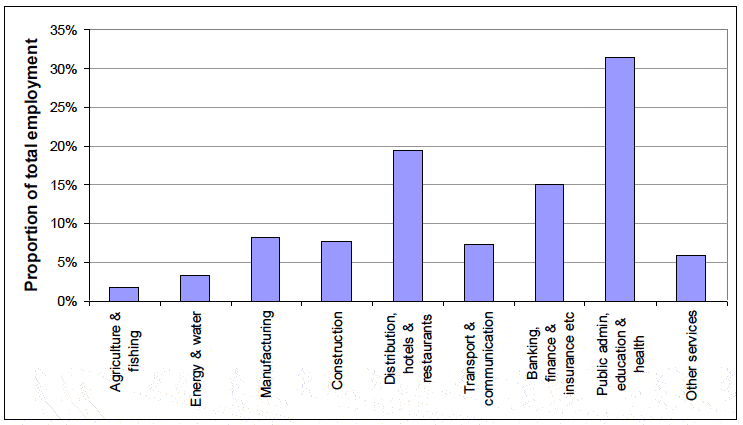
Source: Annual Population Survey, Jan-Dec, ONS
Since 2008, there have been statistically significant changes in the proportions employed within Manufacturing (down 1.9 percentage points), Construction (down 1.7 percentage points), Banking, finance and Insurance (up 2.1 percentage points) and Other services (up 1.0 percentage points). Chart 5 illustrates these changes broken down by gender.
Chart 5 - Change in the percentage employed within each industry sector between 2008 and 2011 by gender, Scotland
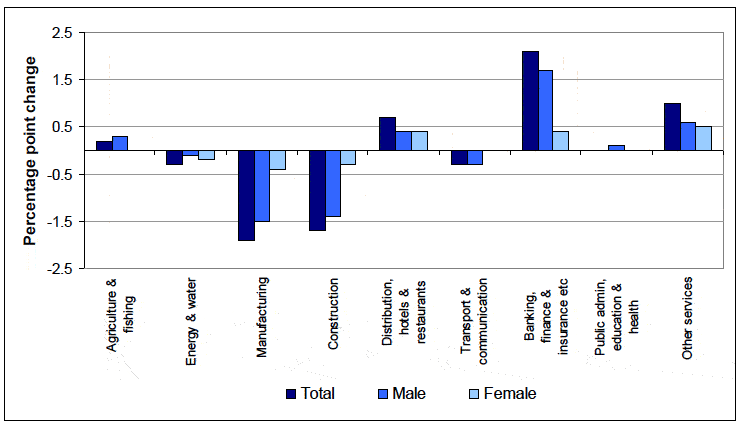
Source: Annual Population Survey, Jan-Dec, ONS
- Around 80% of the change seen in the Manufacturing, Construction and Banking, Finance and Insurance sectors since the start of the recession in 2008 were due to changes in the number of male workers, while changes in the number of female workers accounted for about 50% of the change seen in the Other Services sector.
- Around half of the decreases seen in Manufacturing and Construction sectors were due to reductions in the employment levels of workers aged 35-49.
- Workers aged 25-34 accounted for just under half of the 43,300 increase in employment in the Banking, Finance and Insurance sector, with workers aged 35-49 and 50-64 also seeing increases. Those aged 16-24, however, saw their employment level in this sector decrease.
Impact at Local Authority level between 2008 and 2011
- The national reduction in Manufacturing was driven by reductions in Fife (down 9,700), Glasgow (down 8,700), North Lanarkshire (down 5,300) and South Lanarkshire (down 7,600), which, combined, accounted for just under 60% of the decrease seen in this sector.
- The largest declines within the Construction sector were seen in Edinburgh (down 7,400) Scottish Borders (down 3,300) and Fife (down 3,200), which together accounted for 30% of the overall national decrease in this sector.
- Increases in the level of those employed in Banking, Finance and Insurance within Aberdeen City (up 4.600), Fife (up 5,500) and South Lanarkshire (up 4,600) together accounted for around 35% of the total rise seen at national level in this sector
- Glasgow, Highland and Aberdeen City together accounted for just under half of the total increase seen in employment within the Other Services sector with increases in employment levels of 5,500, 2,300 and 2,200 respectively.
Employment data by industry for each local authority in Scotland is provided in the web tables.
Occupation - Standard Occupational Classification 2000 (SOC 2000)
Note: The following analysis uses the Standard Occupational Classification 2000 codings as opposed to the new SOC 2010 codings which was implemented on the APS from January 2011. The conversion from SOC 2010 to SOC 2000 (and vice versa) is not exact, and this may introduce discontinuities in the time series. Further detail is available at:
http://www.ons.gov.uk/ons/guide-method/classifications/current-standard-classifications/index.html
Based on the APS, in Scotland in 2011:
- The Associate, professional and technical occupational group was the largest, with 15.8% of employed persons working in this group.
- The Process, plant and machine operatives occupation group had the lowest share, with 6.7% of those in employment working in this group.
- Over the year to 2011, the only statistically significant change was in the Associate, professional and technical occupational group, which increased by
1.2 percentage points (representing a rise of 28,500). Just under 60% of this increase was due to a rise in male employment within this group. - Since 2008, there have been statistically significant changes in five of the nine occupations groups:
- Decreases were seen in the percentage of people employed in Administrative and Secretarial occupations (down 1.1 percentage points), Skilled Trades occupations (down 0.9 percentage points) and Process, Plant and Machine Operatives (down 0.8 percentage points).
- Females accounted for just over 90% of the reduction seen in Administrative and Secretarial occupations, while males accounted for 85% of the reduction in both Skilled Trade and Process, Plant and Machine Operatives occupations
- Increases were seen in the percentage of people employed in Associate Professional and Technical occupations and Elementary occupations, which both increased by 0.9 percentage points.
- Males accounted for just under three-quarters of the increase in Associate Professional and Technical occupations, while the increase in Elementary occupations was fairly equally split with females accounting for just over half of the increase.
- Decreases were seen in the percentage of people employed in Administrative and Secretarial occupations (down 1.1 percentage points), Skilled Trades occupations (down 0.9 percentage points) and Process, Plant and Machine Operatives (down 0.8 percentage points).
Impact at Local Authority level between 2008 and 2011
- The increase in those employed in Associate Professional and Technical occupations was dominated by a 12,900 rise in the level within Edinburgh. Increases were seen in 17 other local authorities including South Lanarkshire (up 5,500) and Fife (up 4,400), while decreases were seen in 14 local authorities, including Glasgow City and Falkirk (both down 2,700) and Renfrewshire (down 2,600).
- Glasgow City dominated the increase in those employed in Elementary Occupations, seeing a rise of 12,500, with smaller increases seen in Edinburgh (up 2,800) and Dundee City (up 2,000). Decreases were seen in 18 local authorities, with Renfrewshire, North Ayrshire and Angus all seeing decreases of around 1,400,
- The majority of local authorities (26) saw decreases in their employment in Administrative and Secretarial occupations, with Edinburgh, Glasgow City and Fife seeing the largest decreases (down 5,700, 3,500 and 3,200 respectively). Similarly, reductions in employment in Skilled trades occupations were seen in 23 local authorities, with Fife and Aberdeen City (both down by 3,700) and South Lanarkshire (down 3,100) seeing the largest decreases. Reductions in employment in Process, plant and machine operatives were also seen in the most (25) local authorities, with Glasgow City, (down 4,500) Fife (down 3,500) and South Lanarkshire (2,800) seeing the biggest decreases.
Employment data by occupation for each local authority in Scotland is provided in the web tables.
Occupational Skill Level
The ONS defines occupational skill levels using the following criteria:
| Box 2 - Occupational Skill Levels |
|---|
Skill levels are approximated by the length of time deemed necessary for a person to become fully competent in the performance of the tasks associated with a job. This, in turn, is a function of the time taken to gain necessary formal qualifications or the required amount of work-based training. Low Skill - requires a general education, signalled via a satisfactory set of school-leaving examination grades. In Scotland, the following occupations are typical low skill occupations: elementary personal service occupations (e.g. bar staff, waiters/waitresses) and elementary cleaning occupations. Medium-Low Skill - requires knowledge provided via a good general education as above, but will typically have a longer period of work-related training or work experience. In Scotland, the following occupations are typical medium-low skill occupations: sales assistant, retail cashier and healthcare/personal service occupations (e.g. auxiliary nurse, home carer). Medium-High Skill - requires a body of knowledge associated with a period of post-compulsory education but not to degree level. In Scotland, the following occupations are typical medium-high skill occupations: health associate professional occupations (e.g. nurse, midwife, paramedic) and construction trades. High Skill - requires a degree or equivalent period of relevant work experience. In Scotland, the following occupations are typical high skill occupations: teaching and functional management (e.g. in finance, marketing, public relations, personnel or information technology). |
The occupational skill distribution for each of the key age groups in Scotland is shown in Chart 6 below. The distribution is broadly similar across the key age groups, with the majority (approximately two thirds) of employees in medium-low and medium high skilled occupations and a minority (around 10%) in low skilled occupations. However, the distribution is different for the 16-24 year old age group which has a relatively lower percentage of employees in high skill jobs (6%) and a relatively higher percentage in low skill (25%) and medium-low skill (45%).
Chart 6 - Occupational skill level by age group, Scotland, 2011
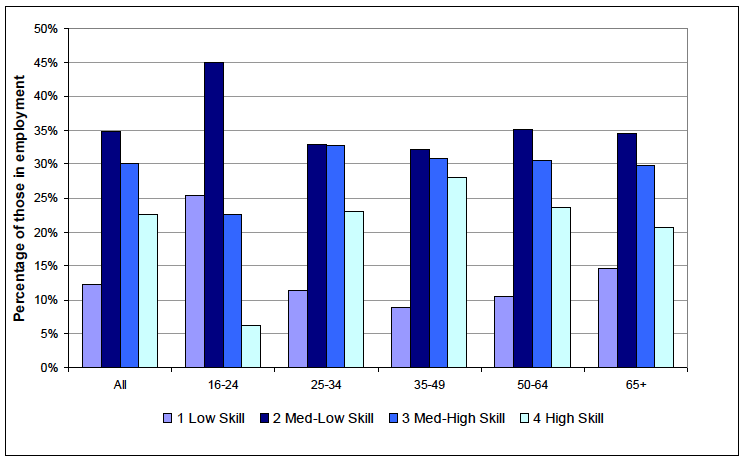
Source: Annual Population Survey, Jan-Dec, ONS
The different distribution for 16-24 year olds may be explained by the fact that it takes time to acquire the relevant qualifications and experience required for high skill occupations.
There are also some interesting differences within the 16-24 year old age group. From Chart 7 we note that there is a different distribution for the occupational skill level of 16-24 year olds who are enrolled in full-time education compared to those who are not in full-time education. The percentage in low and medium-low skill occupations is higher for those enrolled in full-time education, whilst the percentage in medium high and high skill occupation is lower.
The shape of these distributions has been broadly consistent over recent years, however as noted previously, employment decreased for 16-24 year olds in Scotland between 2008 and 2011. Almost all of the decrease in the 16-24 year old employment level was accounted for by those not in full-time education (down 39,100 since 2008). This decrease was a result of decreases in employment in medium-low skill occupations (down 24,200) and medium-high skill occupations (down 19,700).
Chart 7 - Occupational skill level by enrolment in full-time education, 16-24 year olds, Scotland, 2011
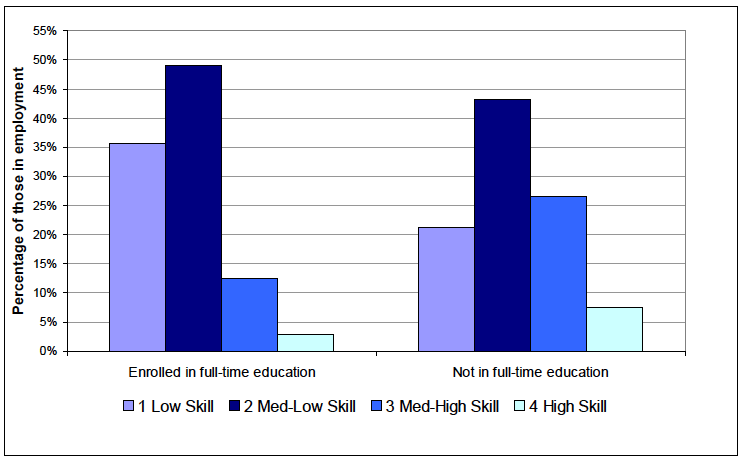
Source: Annual Population Survey, Jan-Dec, ONS
Public and Private Sector
| Box 3 - Public Sector Employment |
|---|
The official source for employment in the public sector at national & regional level is the Quarterly Public Sector Employment series (QPSE). This data is based on administrative data from the various government organisations and bodies that make up the public sector and is based on the National Accounts definition of the public sector. Sources for QPSE in Scotland: http://www.scotland.gov.uk/Topics/Statistics/Browse/Labour-Market/TrendPublicSectorEmp |
The preferred source for estimates of public sector employment disaggregated by gender or age is the Annual Population Survey (APS). Where estimates are reliable, the APS can provide estimates of public/private sector employment by gender or age-group at local area level. However, it should be noted that due to self-classification, the APS tends to over-estimate the size of the public sector.
Estimates from the APS for Jan-Dec 2011 indicate that between 2010 and 2011 the number of people aged 16 and over employed in the public sector in Scotland decreased by 32,900 to 669,800. This represents a reduction in the percentage of people employed in the public sector of 1.3 percentage points, with females seeing a larger decrease (down 24,200 from 451,300 to 427,100 ) than males (down 8,800 from 251,400 to 242,600). In the same period, the number of people employed in the private sector in Scotland increased by 31,400 from 1,744,600 to 1,776,00, with males seeing a higher level of increase (up 21,700 from 1,013,100 to 1,034,800) than females (up 9,600 from 731,500 to 741,100).
Private sector employment had decreased at a faster rate between 2008 and 2009 (down 58,300), reacting more rapidly to the recession, whereas over the same period, public sector employment increased by 22,900. Through 2009 to 2010, private sector employment continued to decrease, but at a slower rate than in the previous year (down 8,400), while public sector employment started to decrease (down 22,900). The latest data indicates that, while the public sector has continued to contract through 2011, there are signs of a recovery in the private sector, with employment levels now recovering to higher levels than those seen in 2009.
Over the year, there is considerable variation in the change in public and private sector employment levels for local authorities, with some areas seeing losses in both sectors, while others have seen increases in one, but decreases in the other.
- City of Edinburgh was the only local authority to see increases in both public and private sectors; (public sector up 1,300 from 64,400 to 65,700, private sector up 5,800 from 178,000 to 183,800).
- In City of Edinburgh, the increase in public sector employment was dominated by an increase of 3,800 in the number of female employees (with the number of male employees decreasing by 2,500), while the 5,800 increase in private sector employment was fairly evenly split between males and females.
- 11 local authorities saw decreases in the levels of both public and private sector employment. Those which saw the largest decreases in their combined levels of public and private sector employment were Dumfries and Galloway (public sector down 1,800 from 18,200 to 16,400, private sector down 2,200 from 48,900 to 46,700) and Clackmannanshire (public sector down 200 from 6,900 to 6,700, private sector down 3,600 from 18,500 to 14,900).
- The 31,400 national increase in private sector employment was dominated by a 20,100 rise in private sector employment in Glasgow. This rise was predominately due to a 15,700 rise in male private sector employment.
Looking at the change in public and private sector employment since the start of the recession in 2008 shows a somewhat different picture to that over the last year. Although public sector employment has decreased by a similar amount (down 31,500 from 701,300 to 669,800), private sector employment is also lower than the level seen in 2008 (down 35,300 from 1,811,300 to 1,776,000)
- Glasgow City and Aberdeen City were the only local authorities to see increases in both public and private sectors; In Aberdeen public sector employment was up 1,100 from 26,600 to 27,700, while private sector employment was up 1,400 from 87,900 to 89,300. In Glasgow public sector employment increased slightly from 73,400 to 73,900, while private sector employment rose by 1,100 from 190,400 to 191,500.
- In Aberdeen, the increase in private sector employment was dominated by an increase of 4,100 in the number of female employees (with the number of male employees decreasing by 2,600), while in Glasgow the increase in private sector employment was driven by an increase of 6,000 in the number of male employees (with the number of female employees decreasing by 4,800).
- 18 local authorities saw decreases in the levels of both public and private sector employment. Those which saw the largest decreases in their combined levels of public and private sector employment were North Ayrshire (public sector down 4,000 from 15,700 to 11,700, private sector down 2,900 from 44,200 to 41,300) and Fife (public sector down marginally from 47,900 to 47,600, private sector down 6,200 from 126,800 to 120,600).
Employment data by public and private sector for each local authority in Scotland is provided in Table 4 in Annex A, with full time series back to 2004 available from the web tables.
Table 5 in Annex A gives estimates for the levels of Public and Private sector employment by age group at national level from for 2004 to 2011, as well as the proportions employed in public and private sector for each age group. From this it can be seen that:
- The largest decreases over the year in public sector employment were in the 35-49, 16-24 and 50-64 age groups, down 16,600, 9,600 and 4,800 respectively.
- Since the start of the recession in 2008, decreases in public sector employment were seen by the 35-49 and 16-24 age groups, down 34,600 and 10,100 respectively. The 25-34, 50-64 and 65+ age groups saw increases of 3,800, 6,300 and 3,200 respectively.
- The largest increases over the year in private sector employment were in the 25-34 and 50-64 age groups, up 18,500 and 11,900 respectively.
- Since the start of the recession in 2008, decreases in private sector employment were seen by the 16-24 and 35-49 age groups, down 30,000 and 26,600 respectively. The 25-34, 50-64 and 65+ age groups saw increases of 10,400, 7,100 and 3,700 respectively.
Chart 8 provides an alternative view of the age group data, showing the makeup of each sector (e.g. the percentage of all public sector workers who are aged 16-24, 25-34 and so on, and similarly for private sector workers) for 2005, 2008 and 2011.
Chart 8 - Percentage of people employed within public/private sectors by age group, Scotland, 2005, 2008, 2011
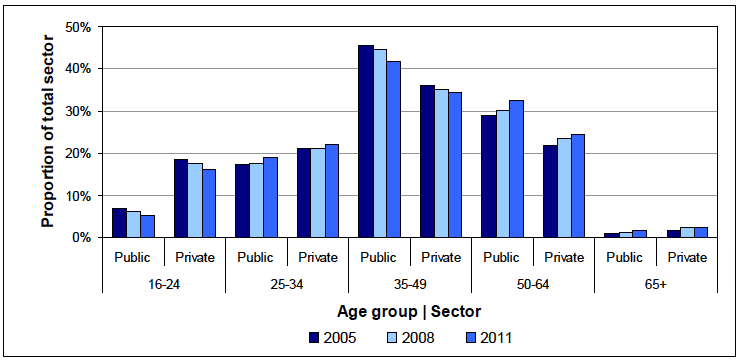
Source: Annual Population Survey, Jan-Dec, ONS.
Contact
Email: Alan Winetrobe
There is a problem
Thanks for your feedback